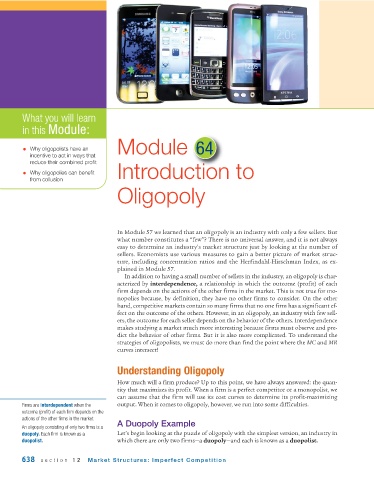Page 680 - Krugmans Economics for AP Text Book_Neat
P. 680
What you will learn
in this Module:
• Why oligopolists have an Module 64
incentive to act in ways that
reduce their combined profit
• Why oligopolies can benefit Introduction to
from collusion
Oligopoly
In Module 57 we learned that an oligopoly is an industry with only a few sellers. But
what number constitutes a “few”? There is no universal answer, and it is not always
easy to determine an industry’s market structure just by looking at the number of
sellers. Economists use various measures to gain a better picture of market struc-
ture, including concentration ratios and the Herfindahl-Hirschman Index, as ex-
plained in Module 57.
In addition to having a small number of sellers in the industry, an oligopoly is char-
acterized by interdependence, a relationship in which the outcome (profit) of each
firm depends on the actions of the other firms in the market. This is not true for mo-
nopolies because, by definition, they have no other firms to consider. On the other
hand, competitive markets contain so many firms that no one firm has a significant ef-
fect on the outcome of the others. However, in an oligopoly, an industry with few sell-
ers, the outcome for each seller depends on the behavior of the others. Interdependence
makes studying a market much more interesting because firms must observe and pre-
dict the behavior of other firms. But it is also more complicated. To understand the
strategies of oligopolists, we must do more than find the point where the MC and MR
curves intersect!
Understanding Oligopoly
How much will a firm produce? Up to this point, we have always answered: the quan-
tity that maximizes its profit. When a firm is a perfect competitor or a monopolist, we
can assume that the firm will use its cost curves to determine its profit-maximizing
Firms are interdependent when the output. When it comes to oligopoly, however, we run into some difficulties.
outcome (profit) of each firm depends on the
actions of the other firms in the market.
A Duopoly Example
An oligopoly consisting of only two firms is a
duopoly. Each firm is known as a Let’s begin looking at the puzzle of oligopoly with the simplest version, an industry in
duopolist. which there are only two firms—a duopoly—and each is known as a duopolist.
638 section 12 Market Structures: Imperfect Competition

